Stedelijk Gymnasium Haarlem
The Stedelijk Gymnasium Haarlem or the Latin School of Haarlem is a secondary school in Haarlem, Netherlands. The school was founded in 1389 and is therefore one of the oldest schools in the world. The school offers voorbereidend wetenschappelijk onderwijs (Preparatory Scientific Education) exclusively and is an independent gymnasium enrolling 822 students and 95 teachers, for a teacher/student ratio of 8.6.
| Latin School of Haarlem Stedelijk Gymnasium Haarlem | |
|---|---|
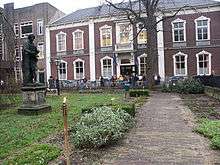 Prinsenhof "hortus" with "Lau" | |
| Address | |
Prinsenhof 3 2011 TR | |
| Information | |
| Type | Gymnasium (school) |
| Motto | Vicit Vim Virtus |
| Established | 1389 |
| Principal | Jan Henk van der Werff[1] |
| Staff | teachers: 67, rest: 20[2] |
| Grades | 6 - 12 |
| Enrollment | 856[2] |
| Student to teacher ratio | 8.6 |
| Newspaper | Mirabile Lectu |
| Website | www |
Admission
The Latin School of Haarlem subscribes to a selective admission policy. A prospective student is required to provide for sufficient material e.g. standardized test scores and a primary school teacher's recommendation. The overall score of the National Standardized Test (Cito-eindtoets) most Dutch students take at the end of sixth grade has to be 85%>. If the student in question does not meet the requirements he or she is not eligible for admission.
History
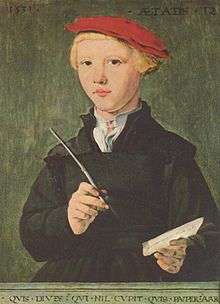
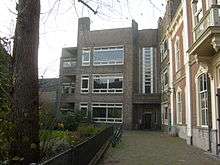
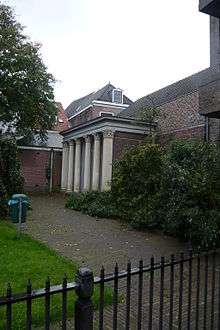
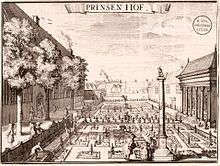
In 1389 a Latin school was begun north of the St. Bavochurch in the Schoolsteeg. After the Siege of Haarlem when the city council seized all Catholic possessions, the school moved in 1592 to the quarters of the old Dominican Order monastery located behind the City Hall. The current school is still located there on the Prinsenhof, that can be reached via the Jacobijnestraat. It still offers a classical curriculum, including studies in Latin and Greek.
The first rector recorded is 'Meester Gheraerde de scoelmeester' in 1301.[3] In 1389 the city was given the privilege of appointing the rector together with the pastor of the Bavo.[3] The rector was paid by the fees paid by students. He also took in students from outside the city and received extra fees for room & board. From his income, he paid the teachers (ondermeesters) himself.[3] The basis for education was the 'artes liberales', whereby parts of the Trivium were given in Latin and the Quadrivium included music, since the choir boys needed to sing in church.[3] For boys studying theology, Hebrew lessons were given in addition to Latin (Greek only became available from 1522).[3] Students wanting to continue their studies, needed to leave the country before the Leiden University was founded in 1579. According to the archives of the Heilige Geest, a religious institution formerly located at what is now the Hofje van Oorschot, they had a fund from 1502 to 1577 (the Satisfactie) for sending good students to Cologne to further their studies there.[3] In 1553, when the school had been run by Junius, they even petitioned Charles V, Holy Roman Emperor for the right to found a university in Haarlem, but this was never answered.[3] After the Satisfactie van Haarlem in 1577, the books of all the monasteries and cloisters in Haarlem were given to the Latin school and the rector Cornelis Schonaeus (1540–1611) took two weeks to draw up the inventory list.[3] This same Schonaeus was the one who was in charge of moving the school from the schoolsteeg to the current location in 1583.[4] He almost lost his job when the council decided to start a collegie or university there, but perhaps because Leiden had already been founded, this never happened. He did complete a major reorganization of the school that was then placed in the hands of his successor, Theodorus Schrevelius.[4]
During the years 1864-1875 and again from 1925–1933, the school merged with the Hogere Burger School (Haarlem), due to a decrease in enrollment.[5]
The Stedelijk Gymnasium Haarlem was the last school in the Netherlands where lessons were taught on Saturday mornings. This was finally discontinued in the school year 2000-2001. The Prinsenhof itself is a historic Hortus Medicus, that used to contain medicinal herbs tended by the students, but is now a grassy garden - with a weeping beech in the middle - tended by the city parks service. A historic statue to Laurens Janszoon Coster that was originally located on the city square, was moved here in 1823 to make way for a new one. Also located in the hortus is a small "peace temple" that was originally placed in 1648 to commemorate the Peace of Münster.
Campus
The campus is located in the old city center of Haarlem. The Latin School occupies two separate building on opposite sides of the Prinsenhof in Haarlem. This arrangement means that public space is a large part of school life. The complex built in 1865 by J.E. van den Arend is restored recently.
Haarlem Model United Nations
The Latin School of Haarlem hosts an annual Model United Nations conference which is organised by the Haarlem Model United Nations Organisation: the Haarlem Model United Nations Conference (HMUN). The Haarlem Model United Nations Organisation is a nonprofit organization run by students of the Stedelijk Gymnasium Haarlem and the Board of Directors.
The Haarlem MUN conference is a three-day conference during which students from schools in the Netherlands and other countries are assigned delegations consisting of countries or non-governmental organizations that they will represent during the conference. They do so in various councils and assemblies, similar to the ones of the real United Nations.
In accordance with the policy of their assigned country or non-governmental organizations the students are involved in lobbying, debating, writing resolutions, and all things normally done by adult diplomats.
Notable alumni
- Amir Sjarifoeddin - Second Prime Minister of the Indonesian Republic
- Thierry Baudet - politician, academic and journalist
- Hadrianus Junius (1550–1552)[3]
- Theodorus Schrevelius - humanist, writer and poet
- Job Cohen - former Mayor of Amsterdam and in 2010 leader of the Labour Party (Netherlands)
- Jessica Durlacher - writer
- Hamengkubuwono IX - Ninth Sultan of Yogyakarta
- Ed Spanjaard - conductor
- L.H. Wiener - writer
- Jan Kops- Baptist preacher and professor agronomy at the University of Utrecht
- Edward Brongersma - Dutch politician, lawyer, jurist and criminologist
- Christianus Cornelius Uhlenbeck - Dutch linguist, anthropologist and writer
- Jan Kruseman - Dutch Jurist and president of the Court of Amsterdam
- Guido van Rossum - Dutch computer programmer
| Dutch Rijksmonument 19666 |
| Wikimedia Commons has media related to Stedelijk Gymnasium, Haarlem. |
See also
- List of the oldest schools in the world
References
- https://www.sghaarlem.nl/onze-school/
- schoolgids 2018-2019 Stedelijk Gymnasium Haarlem, download on https://www.sghaarlem.nl/
- Deugd boven geweld, Een geschiedenis van Haarlem, 1245-1995, edited by Gineke van der Ree-Scholtens, 1995, ISBN 90-6550-504-0, p88
- Schonaeus in the KNAW
- "Article in Dutch on North Holland Archives website". Noord-hollandsarchief.nl. 2006-07-14. Archived from the original on 2012-03-06. Retrieved 2012-01-02.